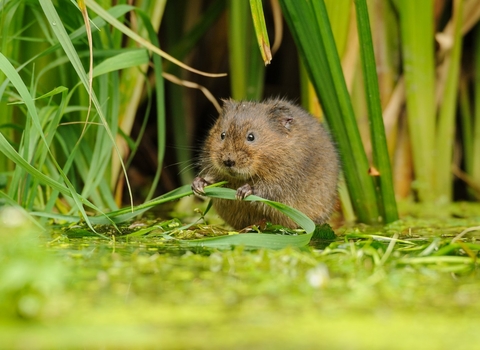
Terry Whittaker/2020VISION

©Margaret Holland
Water vole
Scientific name
Arvicola amphibiusWhen to see
January to DecemberSpecies information
Category
Statistics
Length: 14-22cmTail: 9.5-14cm
Weight: 150-300g
Average lifespan: 0.5-1.5 years
Habitats
About
The water vole lives along rivers, streams and ditches, around ponds and lakes, and in marshes, reedbeds and areas of wet moorland. Look out for the signs of water voles, such as burrows in the riverbank, often with a nibbled 'lawn' of grass around the entrance.Water voles like to sit and eat in the same place, so piles of nibbled grass and stems may be found by the water's edge, showing a distinctive 45 degree, angled-cut at the ends. 'Latrines' of rounded, cigar-shaped droppings may also be spotted. Water voles start to breed in spring, having three to four litters a year of up to five young.
How to identify
The water vole has chestnut-brown fur, a blunt, rounded nose, small ears, and a furry tail. It is much bigger than other vole species. Scotland’s water voles often appear darker, with many having a black coat.The similar brown rat is larger, with grey-brown fur, a pointed nose, large ears that protrude from its fur, and a long, scaly tail.
Distribution
Still widespread throughout mainland UK, though range and numbers have significantly declined. Absent from the Channel Islands, Isles of Scilly, Scottish islands, Northern Ireland and the Isle of Man.In our area
Suffolk has a great resource of potential water vole habitat with river valleys, coastal grazing marshes, ponds, ditches, lakes, fens, and reedbeds. From 2003 to 2007 every river catchment in the county was surveyed for water vole, and the results showed a dramatic decline in water vole populations since the previous county survey done in 1998. Habitat loss and predation by American mink (an invasive non-native species) were believed to be the main causes of this decline.
After this alarming discovery, Suffolk Wildlife Trust helped to slow this decline by working with landowners to improve management practices to protect and enhance water vole habitat and to ensure all protected species legislation is followed. Suffolk Wildlife Trust also set up a mink control programme throughout the county to reduce predation on water vole. This work was part of the Water for Wildlife Project, supported by Anglian Water, Essex & Suffolk Water, and the Environment Agency.
Did you know?
The water vole is famously known as 'Ratty' in Kenneth Grahame's classic children's tale, The Wind in the Willows. Despite being sometimes referred to as a 'water rat', there is no such thing - there are brown rats, black rats and water voles.Suffolk has a great resource of potential water vole habitat with river valleys, coastal grazing marshes, ponds, ditches, lakes, fens, and reedbeds. From 2003 to 2007 every river catchment in the county was surveyed for water vole, and the results showed a dramatic decline in water vole populations since the previous county survey done in 1998. Habitat loss and predation by American mink (an invasive non-native species) were believed to be the main causes of this decline.
After this alarming discovery, Suffolk Wildlife Trust helped to slow this decline by working with landowners to improve management practices to protect and enhance water vole habitat and to ensure all protected species legislation is followed. Suffolk Wildlife Trust also set up a mink control programme throughout the county to reduce predation on water vole. This work was part of the Water for Wildlife Project, supported by Anglian Water, Essex & Suffolk Water, and the Environment Agency.
